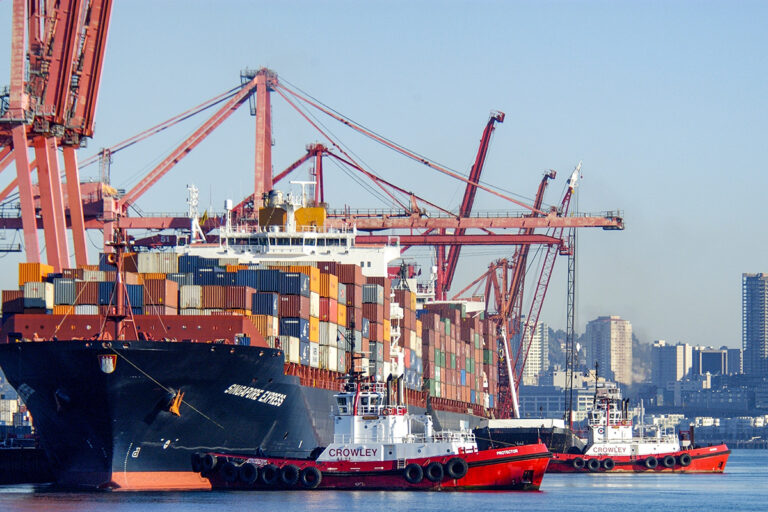Erratic policy, based on the extensive use of executive orders, reduces the country’s superiority in global growth and keeps the probability of a U.S. recession high.
The weak fiscal situation bars support, and the U.S. Federal Reserve will be reluctant to cut rates given inflation uncertainty. Dealmaking over trade should eliminate growth headwinds within three-or-six months.
We expect monetary policy in Europe to become expansionary in 2025, accompanied by growth-supportive fiscal policies in 2026. The rebalancing of global trade will be driven by stronger growth in Europe and Asia, and weaker growth in the U.S.
U.S. economic policy and recession risk assessment
The de-escalation in the trade conflict with the U.S. eases some of the pressure on the Chinese economy, particularly on the export sector. While the truce is a positive development for U.S.-China trade relations, the road ahead is likely to be bumpy, reinforcing the Chinese government’s continued efforts towards greater self-reliance.
Given recent developments, we expect Chinese exports to remain more robust forecasts, projecting the Chinese economy to grow 4.6 per cent in 2025 and 4.0 per cent in 2026. Domestic demand still appears weak, especially in areas that have not been supported by stimulus measures.
However, with the drag on exports reduced, additional stimulus measures are likely to be implemented only in a reactive manner. Over the medium-term, the trade conflict will reinforce the Chinese government’s continued efforts towards greater self-reliance.
Currency volatility and trade tension impact
The USD has weakened into a lower trading range, while easing trade tensions do not foster further consolidation. We expect continued volatility within the EUR/USD 1.10-1.20 range, with a short-term forecast of 1.15. Downside risks remain ample, as the erratic policymaking, the fiscal situation, and external imbalances suggest that more USD weakness is the path of least resistance.
Our longer-term outlook for USD, however, is based less on trade tensions. Current policymaking, the fiscal situation, and external indebtedness suggest that a weaker dollar is indeed the path of least resistance. We therefore signal the case for a long-term USD downturn with a 12-month forecast of EUR/USD 1.12, with our forecast possibly reached only beyond the forecast horizon.

Credit risk management in high-yield markets
Erratic U.S. policy affects bond markets through two channels – increased uncertainty and the broader effect on USD assets – as well as contributing to growth headwinds and resulting default risk.
In combination and at current valuations, this reinforces the stance to opt for measured credit exposure in the crossover space, paired with a balanced duration profile.
Despite the uncertainty and the level shift in dynamics regarding government yields, another way in which tariffs affect bond markets is through the short-term growth drag. Admittedly, whether or not we re-enter a pronounced default cycle pretty much depends on how long the economic slowdown will be.
In any case, there are likely to be more disruptions in the pipeline and, from a risk management perspective, it is prudent to have measured credit risk in portfolios for now. This is especially true given that current spread levels leave little room for error. In practical term, we maintain a preference for the crossover space in USD credits.
Adding the yield pickup to our preferred 3-to-7-year maturity profile results in attractive yields in the range of 5 to 5.5 per cent, with minimal default risk.
Emerging market debt segments have shown remarkable resilience so far and may benefit from a weaker USD, as long as the growth drag does not extend materially. We keep our neutral stance on EM sovereign hard-currency debt, noting that spread levels remain quite tight.
When it comes to EM corporates, fundamental metrics are strong and the EM corporate default rate remains low. We thus maintain our overweight stance on EM hard-currency corporate debt for the time being and would use any spread-widening as an opportunity to add exposure.
After a volatile start to the year, triggered by shifting U.S. tariff policy, equities have largely priced in a favourable scenario. Among nearly 500 large-cap companies that have reported earning so far, just 10 per cent have disclosed direct exposure to tariffs – mostly via increased cost of goods sold.
For firms that have quantified the impact, the average gross margin compression is expected to be around 7 per cent. Depending on cost absorption rates ranging from 10 per cent to 30 per cent, after-tax margins could face a 5 to 15 per cent hit.
The consumer-oriented sectors (cyclicals and defensives) that are already grappling with thin profit margins, appear most at risk – particularly the automotive sector.

The S&P 500 is currently trading at 22.4x forward earnings – levels typically associated with mid-cycle expansion, not a landscape marked by trade policy unpredictability and rising macroeconomic risks.
Meanwhile, the equity risk premium remains compressed relative to historical norms. Earnings expectations have also begun to adjust. Forecasts for 2025 have been revised lower – from 14.5 per cent to a more plausible 9.2 per cent – but the market still assumes 13.4 per cent earnings growth in 2026, which looks increasingly optimistic given the potential headwinds.
We believe the risk/reward profile of U.S. equities has become less attractive. As such, we continue to recommend using periods of strength to gradually reduce U.S. equity exposure and diversify globally.
In particular, we see compelling opportunities in Europe, Japan, China, and India – regions where valuations are more reasonable, earnings expectations are more grounded, and the macroeconomic policy environment appears comparatively constructive.
Our equity analysts have put a focus on sectors and companies whose businesses are not directly impacted and which are also likely to be able to deal with secondary effects, such as a decline in consumer sentiment and currency volatility. The obvious choice are companies generating their revenue exclusively outside the U.S.
Gold as recession hedge and safe haven demand
The damage in the U.S. economy is done and recession risks remain elevated despite the rapprochement. In addition, erratic policy-making keeps uncertainty in the economy and financial markets elevated, which should support the demand for gold as a safe haven. The debate about the status of the USD and U.S. Treasuries as safe havens is another supportive element to demand.
Elevated recession risks remain a cyclical add-on to gold’s structural bull market, which is driven by the strength of central-bank buying. The trade tensions are a manifestation of the multipolar world, which itself is the dominant driver behind central bank gold buying.
We thus expect the established trends to persist, both in terms of safe-haven demand and central-bank buying, although we also acknowledge that volatility is set to stay elevated as trade talks progress. We reiterate our constructive view on gold against this backdrop and believe short-term setbacks should offer longer-term buying opportunities.









